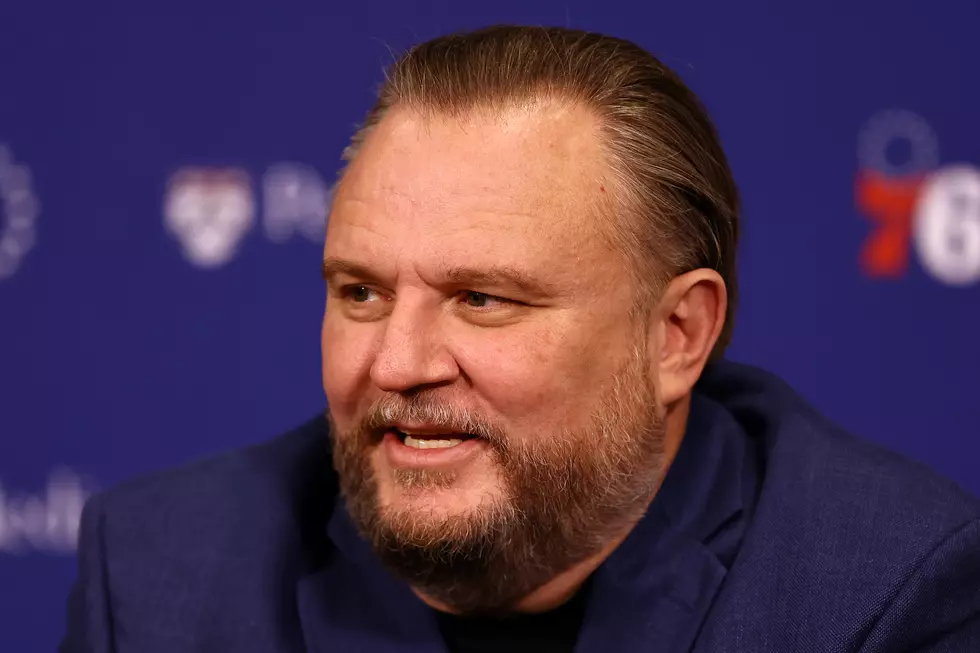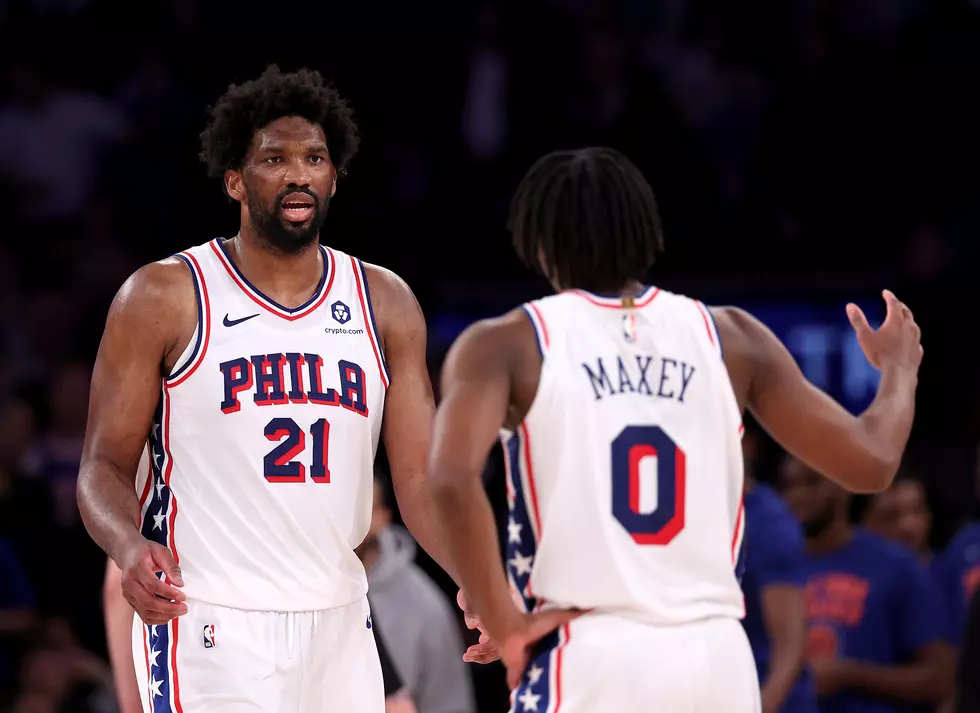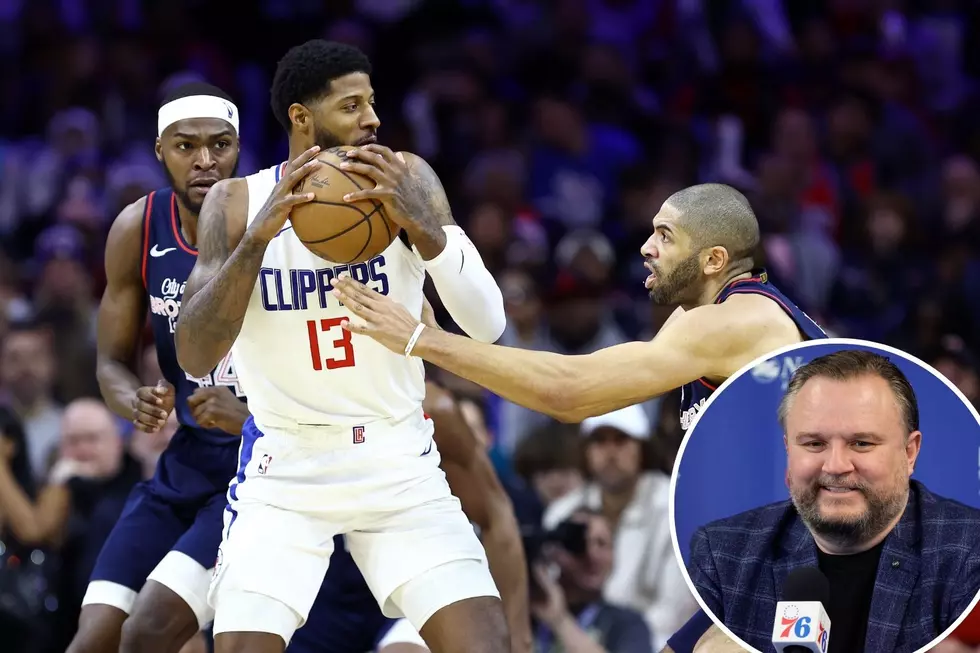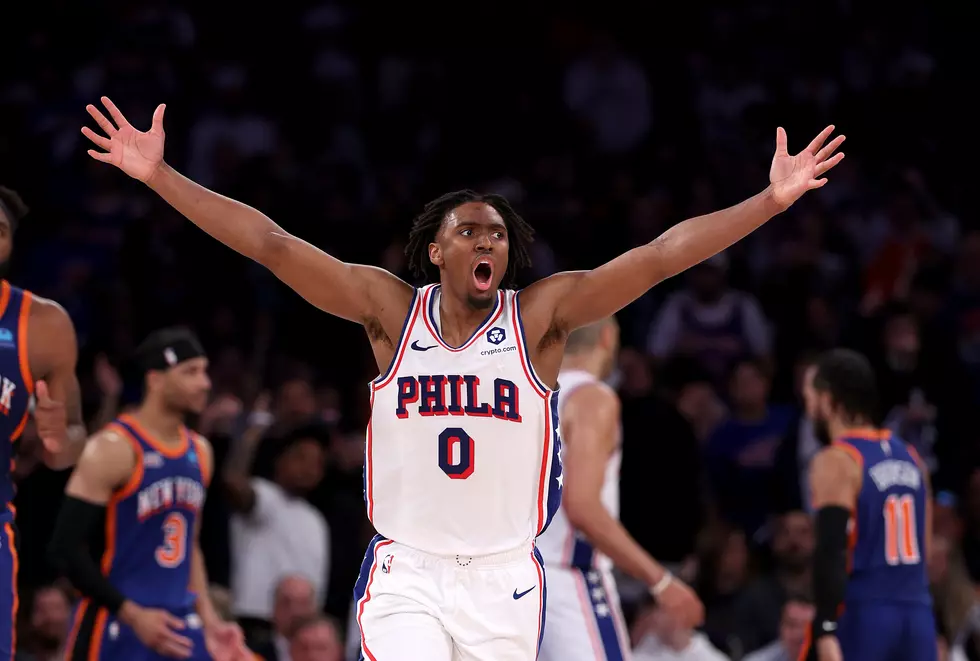
LeBron, Paul George, or Jimmy Butler?: Ranking the top three options for the Sixers’ third star
Since the first days of the offseason, the Sixers have made it clear that acquiring a third star to join the duo of Joel Embiid and Tyrese Maxey will be their primary objective this summer.
The team's president of basketball operations made it even clearer than that. "The biggest need is not at [Embiid and Maxey's] positions," Daryl Morey told reporters at his exit interview. "Someone at the wing who can play and deliver at a high level in the playoffs."
Age will not be a constraint.
Given those parameters, we can rank the three best options to fill that need.
1. LeBron James
Rich Paul made it clear that James will be a free agent this summer. Shams Charania was willing to go on record stating that James is expected to play one or two more years. If that is the case, you're looking at a contract that is either one guaranteed year and a player option in the second year or a two-year guaranteed contract.
James' salary in 2024-25 would be the maximum level for his age tier, which pays 35 percent of that year's cap. For the accountants out there, that is $49.35 million. His salary in 2025-26 would see a five-percent raise, or $51,817,500.
In total, that's up to $101,167,500 for the services of a Hall-of-Fame forward who will turn 40 years old in the early months of next season.
Believe it or not, that all might actually be more of a pro than a con.
Pros
- A two-year horizon would theoretically see James depart in alignment with the end of Embiid's prime. You might have another window of flexibility to re-assess Embiid's powers and gauge where Maxey stands as a star. It could be another chance to make over the team and extend the window if Embiid is still playing at a top-five level or even showing some signs of slowing down. Such a contract would give the Sixers a checkpoint at which they can re-evaluate where they are.
- By virtue of being a free agent, acquiring James would only cost the Sixers money. Unless he does the Lakers a favor and agrees to go to Philadelphia via a sign-and-trade, they would be able to keep their draft capital intact for making impactful trades.
- There are three statistics that I do want to mention, but James' statistics are not central to the argument. He averaged nearly 26 points per game this past season, his age-39 campaign. He shot a career-best 41 percent from three on just over five attempts per game this past season. That doesn't inspire reason to believe that the significant investment James puts into maintaining his body every offseason is due to see substantially diminished returns or his skills are fading any time soon.
But, forget about the statistics and the name on the back of the jersey. There is no more malleable star at James' position. Not only can he toggle between skill sets to impact any environment on any given night, but James also anticipates what guy he'll have to be and when he'll have to be it to get the job done. He's one of the most flexible stars at the wing positions in the NBA, even at his age. He is certainly the most flexible of the lot that could theoretically be available this summer.
Cons
- You might have to draft Bronny James to entice the star forward to make the cross-country move. Perhaps the Sixers like James as a prospect enough to expense one of their picks on him in this month's draft. But, if it's solely for the purpose of attracting his father, drafting Bronny could prove to be a waste of a pick in the long run and a waste of a roster spot in the short-term.
- James historically makes it known when he wants changes made, whether they be at the roster level or above. So, there is potential - if not likelihood - that he'll use his star equity for that purpose if James wants roster moves or organizational changes.
2. The paradox - Paul George or Jimmy Butler
If you just made it back to shore from weeks lost at sea, you might just be finding out that the Sixers have been heavily linked to George and Butler ever since Philadelphia's season came to an end.
The contracts
George has a player option for 2024-25. It appears to be a forgone conclusion that he will decline that option, forcing the Los Angeles Clippers to fork over something resembling a fresh maximum contract or risk losing his services to a franchise more willing to deliver such a payday.
The first year of a George max deal would follow the same math that we did to project James' deal. That is, $49.35 million. His 2025-26 salary would see the same raise that James received in year two. Your calculator should read $51,817,500.
Here's where you might grab your collar and stretch it, longing for some cool air.
Unlike with James, there is no reason to believe that retirement is on George's horizon any time soon. So, there are years of salary left to be calculated.
A 10-percent raise on the first-year salary pays George $54,285,000 in 2026-27. A 15-percent raise on year one pays George $56,752,500 in 2027-28.
In other words, a four-year max contract for Paul George projects out a total cost of $212,205,000.
Butler is a bit of a different story. He has one guaranteed year left on his deal before a player option for 2025-26. Word out of Miami is that Butler wants a two-year extension that would start in 2025-26, replacing the aforementioned option year.
If president Pat Riley's exit interview in early May is any indicator, Miami does not seem thrilled about the idea of paying out a max extension to a star forward who coasts until the games start to have more meaning in the spring. And if that extension is not presented when the calendar deems Butler eligible to ink a new contract, it might be time for Miami to send him to a team that is willing to offer the commitment he wants.
Butler is locked in for $48,798,677 in 2024-25. The first year of his desired extension would be 35 percent of the projected salary cap in 2025-26, paying $54,285,000. The second and final year of the extension would have a five-percent raise on the 2025-26 salary, paying Butler $56,999,250.
That is to say, Butler's contract projects to pay $160,082,927 over three years.
In today's climate, which is characterized by stars locking in the most money possible and then moving via trades later if necessary, most max contracts assume commitments of four or five years.
The Sixers' three best options for adding a star wing/forward illustrate that max contracts shouldn't assume duration alone. Rather, the nature of those deals should be qualified by both salary as a percentage of the cap in that particular season and duration of the overall contract.
Pros of Paul George
- He would be acquired through free agency. So, unless George decides to help his incumbent team on the way out by agreeing to depart via sign-and-trade, the Sixers would simply use their cap space to acquire him. Therefore, they would keep their reserve of draft assets intact for impactful trades.
- George shot 41 percent from three on nearly eight attempts per game this past season. At 6-foot-8 with a high release point, George should be able to maintain shot quality enough to bet on his efficiency from deep as he gets older, even if the context in which those attempts come changes as he ages.
- Not only is he a high-volume three-point shooter in raw numbers, but he's a willing and adept shooter off the catch. He led the Clippers in threes attempted off the catch this past season, knocking in better than 45 percent of those looks. That willingness and skill as a catch-and-shoot threat would play nicely next to Maxey, who the Sixers ostensibly want to control the ball on the perimeter as much as possible.
- That isn't to reduce George to a volume three-point guy with size. Much to the chagrin of Sixers fans, there is some overlap with George and Tobias Harris. George will set up by the short corner or elbow, extending his arm to receive a mid-post touch against the right defender. One of the attributes that should make the locals a bit more open-minded to George is that he has some creative chops on swing passes. If he catches the ball with a defender off balance or out of position, George will make quick work to carve his way into the paint. One of the ways in which he profiles most differently from Harris is that he has strength and craft at the rim, capable of scoring through contact out of drives.
- George scored an excellent 1.054 points per possession as a pick-and-roll ball-handler last season, according to Synergy. So, at the very least, having a wing capable of calling his own number in the pick-and-roll gives you some flexibility with building backcourt combinations while diversifying your offensive attack.
- He played 74 regular-season games in 2023-24, by far his most since playing 77 in his age-28 season.
Cons
- He'll turn 35 years old towards the end of the first year of a max contract.
- Does George playing his most games since 2018-19 this past season mean he's due for some wear and tear and a step backwards with availability and general health?
- As good of a three-point shooter as George is almost regardless of context, he's lost a step with his offensive creativity. He doesn't consistently beat defenders to spots anymore, rendering his isolation moves sometimes useless. It's not uncommon for him to settle for difficult jumpers because his step to the basket isn't quick enough or defenders are able to catch up with his shiftiness off the dribble.
- His three-point rate was rather average for forwards this past season, per Cleaning The Glass. He also didn't get to the rim often. While he was excellent at getting the whistle on non-shooting fouls, he was below average at earning the benefit on contact on his shots.
So, three-point attempts don't dominate his shot volume. He doesn't often get close enough for easy looks at the rim. He's not a notable foul-drawer at this stage of his career. Analytically, that all means you can make the case that he's the antithesis of an efficient scorer. So, how are people supposed to trust that his offensive repertoire will translate as needed for a deep playoff run?
- Steal percentage still suggests that George is adept at using his length and being in the right spots on defense. But, our last memories of him on that end of the floor are of a star who did not take the primary assignment with a playoff series on the line. Instead, he accepted an off-ball role in the corner, away from the action as the Dallas Mavericks picked the Clippers apart. If that doesn't tell you something about the pride he takes in winning, perhaps it tells you something about where he is physically at this stage of his career. We're talking about a guy who has four All-Defensive Team selections and a Defensive Player of the Year finalist on his resume. Either it isn't in there anymore or his priorities were elsewhere when his team was most desperate.
- When you've played in 114 career playoff games, you're inevitably going to have highs and lows. George has had his highlights, but he's also had some high-profile flameouts. The Clippers' collapse against the Denver Nuggets in the 2020 playoffs in the pandemic bubble will live in infamy for the franchise. But, George hitting the side of the backboard on a corner three late in Game 7 will forever be the poster of that meltdown. Playoff pedigree has to matter when weighing George against Butler.
Pros of Jimmy Butler
- Even though Butler prefers the midrange and in, he has the creative chops on offense that George no longer has. Butler is still capable of toggling through decisions quickly from the triple-threat position before attacking off the dribble, pulling up on the way to the basket or committing to finishing the drive. And if he isn't feeling any of those options, Butler is more than happy to and adept at setting up teammates to keep the possession going or finish the job themselves.
- He makes up for a lack of three-point volume with the prowess at the rim and a knack for drawing both shooting and non-shooting fouls. Butler ranked on the 98th percentile amongst forwards in both shooting fouled percentage and floor fouled percentage, per Cleaning The Glass.
- Maxey is regarded as the classic sponge-like young guy, eager to learn from any and every veteran player that passes through Philadelphia. If Butler is the next one to come to town and teaches Maxey how to work the whistles, there will be two guys on the team averaging at least 30 points per game next season.
- He recognizes that individual defensive playmaking and movement on offense can redeem easy scores. Butler is known for anticipating passing lanes and disrupting dribbles, getting out in front of the pack to score easily at the rim. He also scored a very good 1.417 points per possession on cuts this past season, per Synergy. With Butler, it's not about making those plays each and every time they present. It's about striking when the opposition can least afford a breakdown. That is very much part of what makes Butler a killer, even in his mid-30s.
- The locals are (perhaps rightfully) tired of being teased with 50-plus-win seasons, only for the offseason to arrive after the second round of the playoffs. Ever since leaving the Sixers in the summer of 2019, Butler has proven that he is something resembling the terminator when the playoffs start. If you only care about deep playoff runs, you, too, may be Jimmy Butler. He has the biggest thing the Sixers have proven to lack time and time again in this era - the will and personality to bend a playoff game as necessary to get the win.
Cons
- Because Butler is not a free agent, the Sixers will have to use draft capital to acquire him into their cap space. So, there's a case to be made that building the rest of the team becomes more challenging because there's less ammunition for making other trades.
- Butler will turn 35 years old a month before the start of next season and we have no idea how his body will come back from the knee injury that prevented him from suiting up for the playoffs.
- He has played more than 70 regular-season games just twice in his career. There have been some legitimate circumstances that have held him out of games. But, when you compare his play in the postseason to his play throughout the regular season, it suggests that Butler simply does not care until the championship is on the line. When a player with Embiid's history of missing games is the central figure of the team, Butler's coasting matters much more.
- Speaking of Embiid, Butler has never been a liberal three-point shooter. He did hit a career-high 41.4 percent of his triples this past season, but on just 2.4 attempts per game. That's meaningless efficiency. Spacing is a real question, which means fit has to be a real question, too.
- Butler has always made it known when he thinks things should be done differently, whether it be individually, at the team level, or at the organization level. Will there be a time at which he demands to take ball-handling duties away from Maxey? Will he be accepting of a more off-ball role? How do Maxey and his camp feel if Butler seeks more on-ball opportunities?
None of the Sixers' options are perfect. But, James is clearly the best choice if available. If he's not available, the Sixers have themselves a paradox. Either of George and Butler is the right choice. But, the other guy does things that he doesn't necessarily do, and that makes him the wrong choice.
George raises your regular-season ceiling, which inherently raises your playoff ceiling. But, his checkered playoff history makes you less confident in your bet that he's the missing piece in getting Philadelphia to a checkpoint it hasn't hit since 2001.
Butler doesn't necessarily raise your regular-season ceiling, leaving you at risk of a playoff path similar to the one the Sixers faced this past season because Embiid missed time with a meniscus injury. But, when it's time for Game 1, Butler transforms into a different animal, single-handedly changing your outlook regardless of where you started.
If the Sixers are lucky enough to have the opportunity to decide which one they get, it's a decision worth losing sleep over.
Here's Jason Kelce's $2.2 Million Beach House in Sea Isle City, New Jersey
Gallery Credit: Josh Hennig/Townsquare Media
More From 97.3 ESPN









